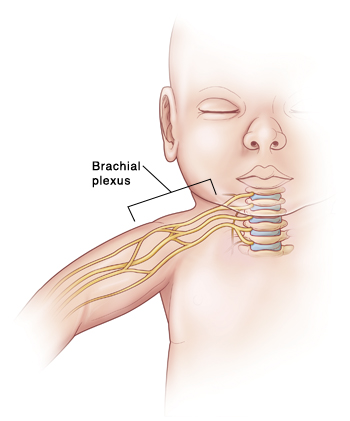When Your Child Has Brachial Plexus Palsy
The brachial plexus is a network of nerves in the neck and shoulder. These nerves carry signals that tell the arm and hand to move. If the brachial plexus is injured, palsy (paralysis) of the arm on that side may result. The brachial plexus can be injured at any time. But injury is most common during childbirth. It usually happens on one side, although it can be on both sides. This condition isn't painful and is usually very treatable. Your child can regain full use of the arm. If your child is diagnosed with brachial plexus palsy, they may be referred to a pediatric orthopedist (specialized in bone and joint problems) or a pediatric neurosurgeon (specialized in treating injuries to the nerves coming from the spine). Brachial plexus palsy is also called Erb or Klumpke palsy.

What causes brachial plexus palsy at birth?
During childbirth, the shoulders may be pulled downward as the baby squeezes through the birth canal. When this happens, the brachial plexus nerves may stretch and be damaged. In some cases, the nerves may even tear. Larger-birth-weight babies are at a higher risk of brachial plexus palsy because it is harder for them to pass through the birth canal.
What are the signs of brachial plexus palsy?
The signs of this problem may be noticed at birth or soon after. The problem may be suspected if the infant:
-
Doesn’t move one arm and the arm hangs limp
-
Shows lack of muscle control in the arm, hand, or wrist
-
Doesn’t seem to have feeling or sensation in one arm or hand
-
Has a droopy eyelid on one side (rare)
How is brachial plexus palsy diagnosed?
The problem is often diagnosed if the healthcare provider notices the signs listed above. Imaging tests such as X-ray, ultrasound, or MRI may be done to rule out other problems. Nerve tests, such as an EMG (electromyography) or nerve conduction study, may be done to check for nerve signals in the upper arm muscle.
How is brachial plexus palsy treated?
Most children with this problem get better on their own once the nerves heal.
-
To keep the arm muscles from stiffening, your child's healthcare provider may advise therapy with an occupational therapist or a physical therapist. During this therapy, the child’s arm is moved through a range of motion. Parents are also shown how to exercise the child’s arm and play a key role in helping their child regain maximum function. Parents then do these exercises at home with the infant 2 to 3 times a day.
-
The child’s condition is monitored for the first 3 to 6 months of the child’s life.
-
Some healthcare providers advise botulinum toxin injections to treat deformities and muscle imbalance linked to brachial plexus injury.
-
In rare cases, surgery can be done to try to restore arm function. This may be needed if the child doesn’t get better within 6 months. Or if nerve studies show that the damage is quite major. Your child’s healthcare provider can tell you more about the surgery if it is needed.
What are the long-term concerns?
Most children regain close to full movement and flexibility of their arm once the brachial plexus nerves heal. After healing, the arm on the side of the injury may be slightly smaller than the other arm. This size difference won’t get worse, and it may improve as the child grows.
Online Medical Reviewer:
Amy Finke RN BSN
Online Medical Reviewer:
Dan Brennan MD
Online Medical Reviewer:
Rita Sather RN
Date Last Reviewed:
10/1/2024
© 2000-2025 The StayWell Company, LLC. All rights reserved. This information is not intended as a substitute for professional medical care. Always follow your healthcare professional's instructions.